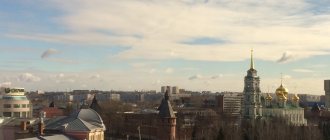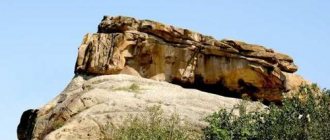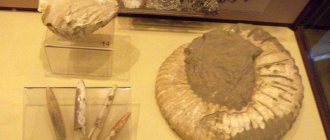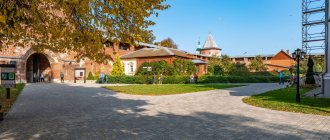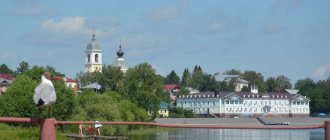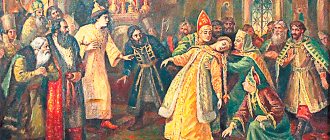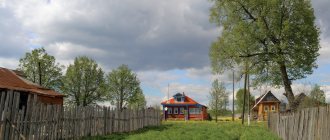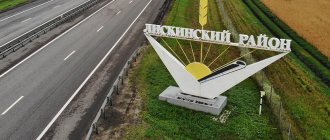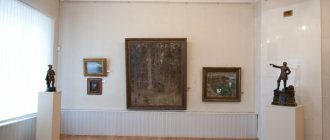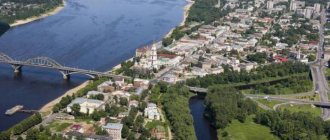The Museum of Porridge and Kashin Traditions is a unique place where you can go with the whole family and enjoy the cozy atmosphere of traditional Russian life.
Historically, porridge has been a staple food in many countries around the world, including Europe and Africa. In Russia, it is second in importance only to soups. The owner of the museum personally guides visitors through the hall and talks about the traditions and history of that time.
© Official VK group, Museum of Porridge and Kashin Traditions
Despite the small area of the museum, it is still worth a visit. A unique collection of dishes is exhibited here: cast iron pots, pots, sieves and archaeological finds of ceramics - the same age as the Egyptian pyramids.
© Official VK group, Museum of Porridge and Kashin Traditions
And also wooden carved spoons, a cereal wheel, ancient recipes for porridges - not only buckwheat or oats, but also kulagi, oatmeal, simenukha; Russian stove and household items. All this can be found in the colorful Museum of Porridge and Kashin Traditions.
Carved spoons, © VK Official Group, Museum of Porridge and Kashin Traditions
The museum has been located in an old mansion in the center of Kashin since 2014. In the first half of the 19th century, this estate belonged to the merchants Zapenin, and after the revolution bagels were sold here.
Today, work continues to restore the architectural forms of the estate. The first floor is occupied by the Porridge Museum and a souvenir shop, the second is warehouse space, and the third is under restoration. There are plans to recreate the historical interiors and improve the surrounding area.
Excursions to the Museum of Porridge and Kashin Traditions
The Museum of Porridge and Kashin Traditions provides excursion programs for adults and children. This is a good opportunity to spend time together as a class, company, tourist group or family.
For children
Young observers will enjoy the program “Visiting the Brownie” . In the process, the children will learn about many Russian customs, rituals and culture.
There are no prim caretakers or glass-enclosed exhibits in the museum. Therefore, children will be able to touch, try and even play Russian folk games. A costume performance with accordions and dancing will brighten up the atmosphere.
© Official VK group, Museum of Porridge and Kashin Traditions
This will be followed by a gastronomic master class “Knead and put in your mouth” and a tasting of prepared porridge with gingerbread. If desired, and for a fee, you can paint Kashin gingerbread, make rag dolls, bast or linen toys, and souvenirs.
The duration of the event is 1–1.5 hours.
© Official VK group, Museum of Porridge and Kashin Traditions
For adults
The Porridge Museum has three programs for adults.
“There is a Russian soul in porridge” includes historical information about the origin of porridge, recipes for its preparation and stories about the healing properties of cereals. The culmination is cooking porridge and tasting the dish with a cup of aromatic tea. The duration of the event is 1.5 hours.
“Merchant Tea Party” is the embodiment of a real Russian tea tradition. Here the emphasis falls on the origin of the hot drink and, of course, tea drinking with sweets and pastries. The duration of the event is 1 hour.
“They came here for porridge...” - an excursion during which you will learn that the saying “you can’t spoil porridge with butter” was born due to the confluence of two rivers, as well as what varieties were preferred by the emperors of the Romanov dynasty. If you are interested in learning about the age-old traditions and proverbs associated with Russian food, then you should choose this program.
At the end of the tour, master classes on gingerbread painting and tasting of porridge with tea are held. The duration of the event is 1 hour 40 minutes.
© Official VK group, Museum of Porridge and Kashin Traditions
Topics of master classes for adults and children may vary. Making a rain flute or painting Easter eggs, making candles from natural wax or baking unleavened sourdough peasant bread - you need to find out the current program of the museum by phone or on the official website.
© Official VK group, Museum of Porridge and Kashin Traditions
You can visit here without pre-booking a tour. However, tourists are recommended to warn in advance about their visit in order to try kvass and delicious freshly prepared porridge.
Kashinsky Museum of Local Lore
About the history and collections of the museum
The small provincial town of Kashin, Tver Region, is famous not only for its centuries-old history and the numerous historical and architectural monuments located within its borders. The main asset of the city is its people, patrons and benefactors, for whom the development of Kashin was one of the main tasks and life position. Thus, the Manukhin merchants donated considerable funds for the improvement of the Church of the Entry of the Lord into Jerusalem, the merchant Ivan Grigorievich Zhdanov, using his own savings, paved the streets of the city with stone and built three bridges across the Kashinka River, and the merchant, hereditary honorary citizen of the city, local historian and enthusiastic collector Joasaf Yakovlevich Kunkin ( 1835 - 1908) laid the foundation for the future museum of local history, providing his mansion on Pushkinskaya Embankment for the exhibits he collected throughout the area and purchased.
After the death of I. Ya. Kunkin, his heirs carefully preserved the collected exhibits, and after the founding of the Historical and Archaeological Museum in November 1918 (as the local history museum was called at the very beginning), they handed over collections numbering more than five thousand items (paintings, national costumes and portraits residents of Kashin and Rostov) on its balance sheet.
Initially, for the museum, which officially opened to visitors in February 1919, the city authorities allocated the building of the former City Duma, and with the abolition and closure of the Church of the Entry into Jerusalem in 1936, the funds were transferred to its vacant and more spacious building.
In 1992, the museum’s exhibitions were updated and currently all nine halls are divided by topic and cover the history of the life of the Kashin residents during the 18th–20th centuries.
Thus, peasant life is represented by interesting objects - furniture, kitchen utensils, agricultural tools and costumes of peasant women of the 19th century, as well as the interiors of peasant houses and a model of a peasant inn made in great detail.
The life of the merchant class is illustrated by the outfits and decorations of merchant women, as well as pieces of furniture and old family photographs from the former noble estate of the Likhachevs and a collection of French porcelain with images of the campaigns of the Napoleonic army, acquired by the owner of the Ustinovo estate L. Ya. Likhachev in 1830 during a trip to Europe.
Other exhibition halls are designed no less interestingly - visitors seem to be transported back in time, passing through each of them in turn and, thanks to well-placed exhibits, plunging into the life of past generations of Kashin residents - either taking a promenade along a city street, or looking into a noble living room, a tavern or a merchant's shop .
One of the halls of the museum is dedicated to Kashin artists, the other - to ancient works of Kashin masters, which presents porcelain figurines, lace and beadwork, the third - to church themes with works of local isographers and church utensils, and tells about the nature and views of Kashin from the late 19th - early 20th centuries a whole collection of photographs.
Currently, the museum has more than 15 thousand exhibits, and 11.5 thousand of them are items of the main fund; there is a scientific library and archive. In addition to the exhibition activities, the museum staff conducts excursions “Antiquities and Antiquities of the Kashin Region” and lectures dedicated to Kashin and people in one way or another connected with this ancient Russian city.
Information for visitors
- The Kashin Museum of Local Lore is located at the address: Tver region, Kashin city, Baseinaya street, house No. 5.
- The museum's doors are open to visitors on Wednesday, Friday, Saturday and Sunday from 11.00 to 17.00, on Thursday from 13.00 to 21.00. Days off are Monday and Tuesday.
Festivals and holidays
Every year the Kashi festival is held on the museum grounds. As part of the festival, competitions for cooks, craft fairs are held, and the organizers prepare the dish in a huge cauldron designed for 1000 liters.
Festival participants can play Seliger ryukhi, try on chain mail, shoot a musket, or learn Celtic folk dances. In a word, plunge into a very special world of everyday life.
© Official VK group, Museum of Porridge and Kashin Traditions
Celebrations such as Maslenitsa or New Year do not pass by the Porridge Museum. These days a special reception is held here with an excellent entertainment program.
Museums and galleries in Kashin
The Kashinsky Museum of Local Lore, one of the oldest in the Tver region, was organized in 1918 and opened in February 1919. The basis of the museum collection was the private collection of the merchant, member of the Tver Scientific Archival Commission I. Ya. Kunkin. His son V.I. Kunkin became the first head of the museum (until 1925).
At the origins of the museum were: photographer, artist, former employee of the Pulkovo Observatory - V. A. Kolotilshchikov, professor, scientific secretary of the Rumyantsev Museum, and later of the Russian State Library - K. A. Stratonitsky. It was decided to create 3 departments in the museum: historical-archaeological, ethnographic-economic and natural-historical.
The museum collections in 1919 numbered about 7,000 items: antique clothing, dishes, portraits, engravings, manuscripts, numismatics, icons, books, etc. Through the efforts of members of the museum organizational commission, valuables from the noble estates of Kashinsky district were saved from looting. An archival department was also organized at the museum, where the archives of the Kashinsky court, police, noble and other institutions were brought. The population turned to the museum for certificates from metric books. With the assistance of K. A. Stratonitsky, a county act depository was established in Kashin in November 1919, where archival funds were transferred from the museum.
Since 1920, the Kashin Society of zealots for the study of the local region and the protection of ancient monuments and arts has worked at the museum. Initially, the curator of the museum, V. I. Kunkin, was elected its chairman, and in 1923–1930, S. V. Kislovskoy, a researcher at the museum, was elected.
Since 1922, the Kashinsky Museum came under the jurisdiction of the Tver Regional Museum. In 1923, the museum was transferred from the Kunkin house to the former mansion of A.P. Dorogutin (it occupied the top floor). In 1928, the museum was reorganized from Historical and Archaeological to Local History (three sections - nature, economics, history of the local region). The functions of the museum then included supervision of historical monuments. In 1928, there were 10 churches under the protection of the museum. From 1932 until now, the Kashin Museum has been located in the building of the Church of the Entrance to Jerusalem from the late 18th century. The relics of St. Anna Kashinskaya were on display at the museum from the moment of their opening in January 1930 until 1948.
The museum continued to operate in 1941–1945. Military actions did not affect the Kashinsky district. The work of museum workers was limited to the partial reception of exhibits and the organization of exhibitions about the Great Patriotic War. In March 1946, the executive committee of the district council noted that the museum still did not have departments for nature, social construction, or the Great Patriotic War. To help the museum in its reorganization, the executive committee of the district council decided to approve the Museum Council from representatives of the public, to ask the executive committee of the regional council to allocate another 26 thousand rubles in addition to the approved 10 thousand rubles for major repairs of the museum and the creation of a social construction department.
In 1977, when the regional association of museums was created, the Kashinsky Museum of Local Lore became one of the first branches of the Kalinin (now Tver) State United Museum.
The modern exhibition, created in 1992, is built in such a way that the visitor finds himself either in a peasant hut, or in a tavern, or in a merchant's shop, a noble living room, or on a city street. A gallery of merchant portraits of the first half of the 19th century, samples of merchant and noble costume are presented. Photos by V.A. Kolotilshchikov (1868–1958) recreate the appearance of old Kashin. These works were awarded a silver medal at the World Photographic Exhibition in Moscow (1907) and a certificate at the World Photographic Exhibition in Paris (1911).
Kashin - the charm of genuine antiquity
Attractions map
1. Earthen ramparts of the Kremlin 2. Resurrection Cathedral 3. Church of the Entrance to Jerusalem 4. Ascension Church 5. Dvor 6. Trading Rows 7. Church of the 8. Elias (Preobrazhenskaya) Church 9. Church of the Nativity “on the Mountain” 10. Residential building ( Proletarskaya St., ½) 11. Mansion of the grain merchant A. Zhdanov 12. Klobukov Monastery 13. Church of Florus and Laurus 14. Church of Peter and Paul
Main stages of development
The founding date of the town is 1287, but its first mention in chronicles dates back to 1238, when Kashin was besieged by the Tver people. It is curious that one of the legends names Moscow Prince Yuri Dolgoruky as the organizer of Kashin, but it does not seem plausible at all. The sharp bend of the river, cutting off most of the land from the hill (Dukhovskaya Mountain), turned out to be very useful in a strategic sense: in the XIII-XV centuries. military fortifications were erected here. In the 17th century the kilometer-long perimeter of the defensive belt consisted of cage-like log buildings with internal filling with earth and stones, interspersed with 15 tetrahedral towers, 4 of which had passages. In the 20th century During excavations at the site of the fortress, the remains of another tower were discovered - Tainichnaya, from which a secret passage supposedly led to the river.
Lavas (bridges across the river) in Kashin
Today, when nothing remains of the formidable Kashin citadel with earthen ramparts (1) and ditches, it is difficult to believe in its important strategic significance. In those distant times, Kashin was a “bone of discord” between Moscow and Tver, who each wanted to annex it to their principality. Despite the fact that the fortress city strived for independence and even minted its own “pul” coin, and in the XIV-XV centuries. visited the center of an appanage principality, it nevertheless submitted to Tver, and in 1485, with the Tver lands, it became part of the Moscow state.
Kashin, Resurrection Cathedral from a bird's eye view

